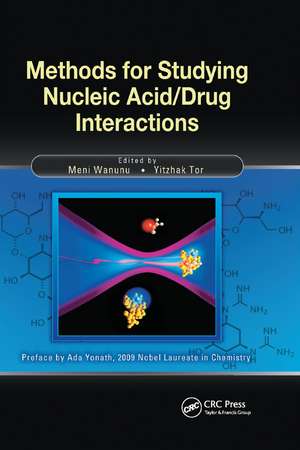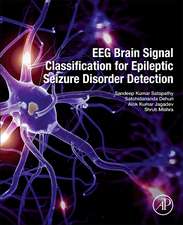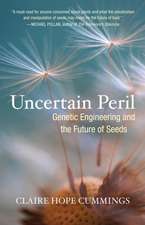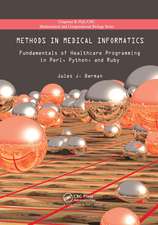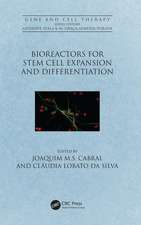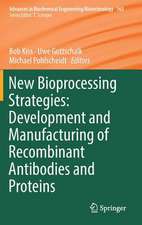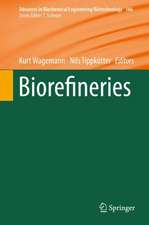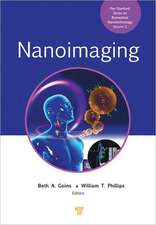Methods for Studying Nucleic Acid/Drug Interactions
Editat de Meni Wanunu, Yitzhak Toren Limba Engleză Paperback – 21 noi 2018
A variety of novel methods for these studies have emerged in recent years, and Methods for Studying DNA/Drug Interactions highlights new and non-conventional methods for exploring nucleic acid/ligand interactions. Designed to present drug-developing companies with a survey of possible future techniques, the book compares their drawbacks and advantages with respect to commonly used tools. Perhaps more importantly, this book was written to inspire young scientists to continue to advance these methods into fruition, especially in light of current capabilities for assay miniaturization and enhanced sensitivity using microfluidics and nanomaterials.
| Toate formatele și edițiile | Preț | Express |
|---|---|---|
| Paperback (1) | 461.03 lei 6-8 săpt. | |
| CRC Press – 21 noi 2018 | 461.03 lei 6-8 săpt. | |
| Hardback (1) | 1335.69 lei 6-8 săpt. | |
| CRC Press – 20 dec 2011 | 1335.69 lei 6-8 săpt. |
Preț: 461.03 lei
Preț vechi: 542.39 lei
-15% Nou
Puncte Express: 692
Preț estimativ în valută:
88.23€ • 91.77$ • 72.84£
88.23€ • 91.77$ • 72.84£
Carte tipărită la comandă
Livrare economică 14-28 aprilie
Preluare comenzi: 021 569.72.76
Specificații
ISBN-13: 9781138382039
ISBN-10: 1138382035
Pagini: 408
Ilustrații: 154
Dimensiuni: 156 x 234 mm
Greutate: 0.45 kg
Ediția:1
Editura: CRC Press
Colecția CRC Press
Locul publicării:Boca Raton, United States
ISBN-10: 1138382035
Pagini: 408
Ilustrații: 154
Dimensiuni: 156 x 234 mm
Greutate: 0.45 kg
Ediția:1
Editura: CRC Press
Colecția CRC Press
Locul publicării:Boca Raton, United States
Cuprins
CLASSICAL TECHNIQUES: Using Spectroscopic Techniques to Examine Drug-DNA Interactions. Probing DNA and RNA Interactions with Biogenic and Synthetic Polyamines: Models and Biological Implications. EMERGING TECHNIQUES: Mass Spectrometry-Based Techniques for Studying Nucleic Acid/Small Molecule Interactions.
Real-Time Monitoring of Nucleic Acid Interactions with Biosensor-Surface Plasmon Resonance. Studying Aptamer/Ligand Interactions Using Fluorescence Correlation Spectroscopy. Studying Nucleic Acid - Drug Interactions at the Single Molecule Level Using Optical Tweezers. Fluorescent Nucleoside Analogues for Monitoring RNA–Drug Interactions. Atomic Force Microscopy Investigation of DNA-Drug Interactions. Characterizing RNA-Ligand Interactions Using 2-Dimensional Combinatorial Screening. EPR Spectroscopy for the Study of RNA-Ligand Interactions. Electrochemical Approaches to the Study of DNA-Drug Interactions. Nanopore Ion Microscope for Detecting Nucleic Acid/Drug Interactions. A Primer for Relaxation Kinetic Measurements. DNA-Drug Interactions: A Theoretical Perspective. Computational Studies of RNA Dynamics and RNA-Ligand Interactions.
All chapters include case studies, background and basics, prospects and outlook, conclusions, and references
Real-Time Monitoring of Nucleic Acid Interactions with Biosensor-Surface Plasmon Resonance. Studying Aptamer/Ligand Interactions Using Fluorescence Correlation Spectroscopy. Studying Nucleic Acid - Drug Interactions at the Single Molecule Level Using Optical Tweezers. Fluorescent Nucleoside Analogues for Monitoring RNA–Drug Interactions. Atomic Force Microscopy Investigation of DNA-Drug Interactions. Characterizing RNA-Ligand Interactions Using 2-Dimensional Combinatorial Screening. EPR Spectroscopy for the Study of RNA-Ligand Interactions. Electrochemical Approaches to the Study of DNA-Drug Interactions. Nanopore Ion Microscope for Detecting Nucleic Acid/Drug Interactions. A Primer for Relaxation Kinetic Measurements. DNA-Drug Interactions: A Theoretical Perspective. Computational Studies of RNA Dynamics and RNA-Ligand Interactions.
All chapters include case studies, background and basics, prospects and outlook, conclusions, and references
Notă biografică
Meni Wanunu completed his Ph.D. in 2005 at the Weizmann Institute of Science, where he specialized in supramolecular chemistry, self-assembly, and nanomaterials science. He then carried out a postdoctoral position at Boston University and a research associate position at the University of Pennsylvania, where he developed ultrasensitive synthetic nanopores for nucleic acid analysis at the single-molecule level. Currently, he is an Assistant Professor at the Department of Physics and the Department of Chemistry and Chemical Biology at Northeastern University, Boston. His research interests include developing chemical approaches for investigating biomolecular structure and behavior, nucleic acid mechanics and dynamics, and probing biological processes at the single-molecule level.
Yitzhak Tor carried out his doctorate work at the Weizmann Institute of Science, earning his Ph.D. in 1990. After a postdoctoral stay at the California Institute of Technology (1990–1993), he took his first faculty position at the University of Chicago. In 1994, he moved to the University of California, San Diego, where he is currently a Professor of Chemistry and Biochemistry and the Traylor Scholar in Organic Chemistry. His research interests are diverse and include chemistry and biology of nucleic acids, the discovery of novel antiviral and antibacterial agents, as well as the development of cellular delivery agents and fluorescent probes. He is currently the Editor in Chief of Perspectives in Medicinal Chemistry (http://la-press.com/journal.php?journal_id=25) and Organic Chemistry Insights (http://www.la-press.com/organic-chemistry-insights-journal-j104). Away from chemistry, his interests are predominantly in music, playing, recording and producing his own instrumental CDs.
Yitzhak Tor carried out his doctorate work at the Weizmann Institute of Science, earning his Ph.D. in 1990. After a postdoctoral stay at the California Institute of Technology (1990–1993), he took his first faculty position at the University of Chicago. In 1994, he moved to the University of California, San Diego, where he is currently a Professor of Chemistry and Biochemistry and the Traylor Scholar in Organic Chemistry. His research interests are diverse and include chemistry and biology of nucleic acids, the discovery of novel antiviral and antibacterial agents, as well as the development of cellular delivery agents and fluorescent probes. He is currently the Editor in Chief of Perspectives in Medicinal Chemistry (http://la-press.com/journal.php?journal_id=25) and Organic Chemistry Insights (http://www.la-press.com/organic-chemistry-insights-journal-j104). Away from chemistry, his interests are predominantly in music, playing, recording and producing his own instrumental CDs.
Recenzii
"By focusing on a selection of novel and emerging techniques, Wanunu and Tor provide a remarkable overview of biophysical and computational advances in structure-based investigations of the interactions between nucleic acids and small-molecule ligands. An impressive collection of approaches is described: analytical biophysical techniques alongside novel exploitation of chemical and computational tools. Indeed, the smart combination of results obtained by classical methods with state of the art biophysical approaches reveals astonishing insights, thus paving new research avenues in this central area of research."
—Prof. Ada Yonath, Weizmann Institute of Science, 2009 Nobel Laureate in Chemistry
—Prof. Ada Yonath, Weizmann Institute of Science, 2009 Nobel Laureate in Chemistry
Descriere
This book describes emerging, non-conventional methods for probing the interactions of small molecules with nucleic acids as well as modern computational methods for assessment. By highlighting novel methods for nucleic acid/ligand interactions, the text presents drug developing companies with a survey of possible future techniques as well as their drawbacks and advantages with respect to common techniques. In addition, and perhaps more importantly, this book is designed to inspire young scientists to continue and advance these methods into fruition, especially in light of current capabilities for assay miniaturization and enhanced sensitivity using microfluidics and nanomaterials.
